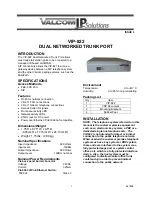
DSL-G624T Wireless ADSL Router User Guide
using multiple APs on your network and are experiencing low throughput or significant transmission delay,
carefully consider how channels are assigned to the different APs.
Wireless Security
Various security options are available on the Router including open or WEP and WPA.
Installation Considerations
Many physical environmental factors can impact wireless networks. Radio waves are used to carry the
encoded data between devices. These radio transmissions can become degraded due to signal attenuation,
multi-path distortion and interference or noise. Attenuation simply means that the strength of the signal
weakens with the distance it travels, even if the transmission path is unobstructed. Multi-path distortion
occurs when radio signals bounce off objects like walls, ceilings, metal appliances, etc. This may cause a
signal to be duplicated, with each separate yet identical signal arriving at a receiver at different times.
Interference and noise from electrical devices such as microwave ovens, fluorescent lights, automobile
engines and other radio emitting devices can cause signal degradation. With all of this in mind, choose a
location for all your access points including the DSL-G624T.
The access point can be placed on a shelf or desktop, ideally you should be able to see the LED indicators on
the front if you need to view them for troubleshooting.
Wireless networking lets you access your network from nearly anywhere you want. However, the number of
walls, ceilings, or other objects that the wireless signals must pass through can limit signal range. Typical
ranges vary depending on the types of materials and background RF noise in your home or business. To
range and signal strength, use these basic guidelines:
Keep the number of walls and ceilings between the DSL-G624Tand other network devices to a minimum -
each wall or ceiling can reduce your D-Link wireless product’s range from 3-90 feet (1-30 meters.) Position
your devices so that the number of walls or ceilings is minimized.
Be aware of the direct line between network devices. A wall that is 1.5 feet thick (.5 meters), at a 45-degree
angle appears to be almost 3 feet (1 meter) thick. At a 2-degree angle it looks over 42 feet (14 meters) thick!
Position devices so that the signal will travel straight through a wall or ceiling (instead of at an angle) for
better reception.
Materials can impede the wireless signal - a solid metal door or aluminum studs may have a negative effect
on range. Try to position wireless devices and computers with wireless adapters so that the signal passes
through drywall or open doorways and not dense, especially metallic, materials. Also, note that metal filing
cabinets and appliances can reflect radio signals. When these metal objects are moved around, your wireless
network may be affected.
Keep your product away (at least 3-6 feet or 1-2 meters) from electrical devices or appliances that generate
extreme RF noise such as microwave ovens, CRT monitors, motors, etc.
4













































